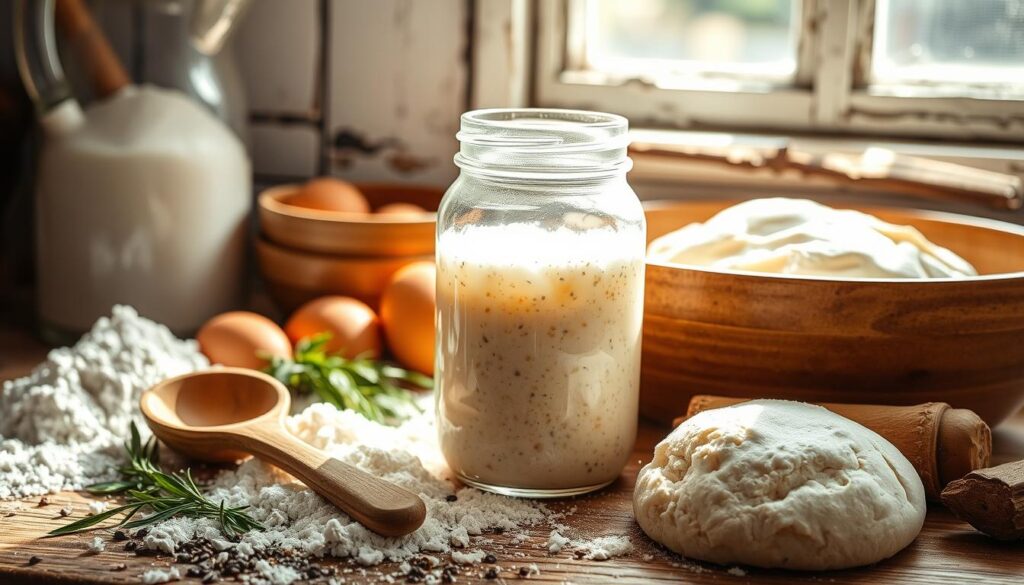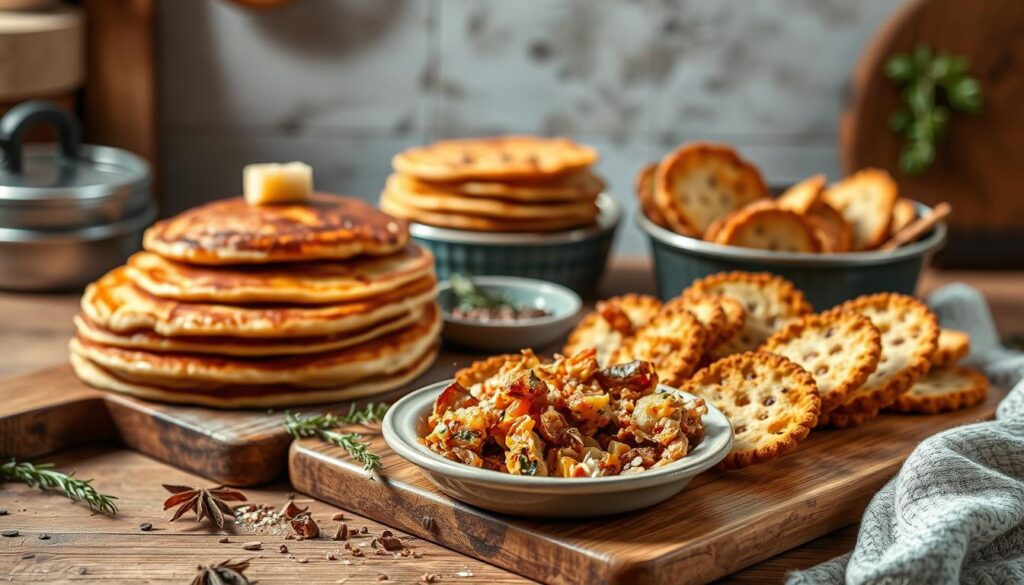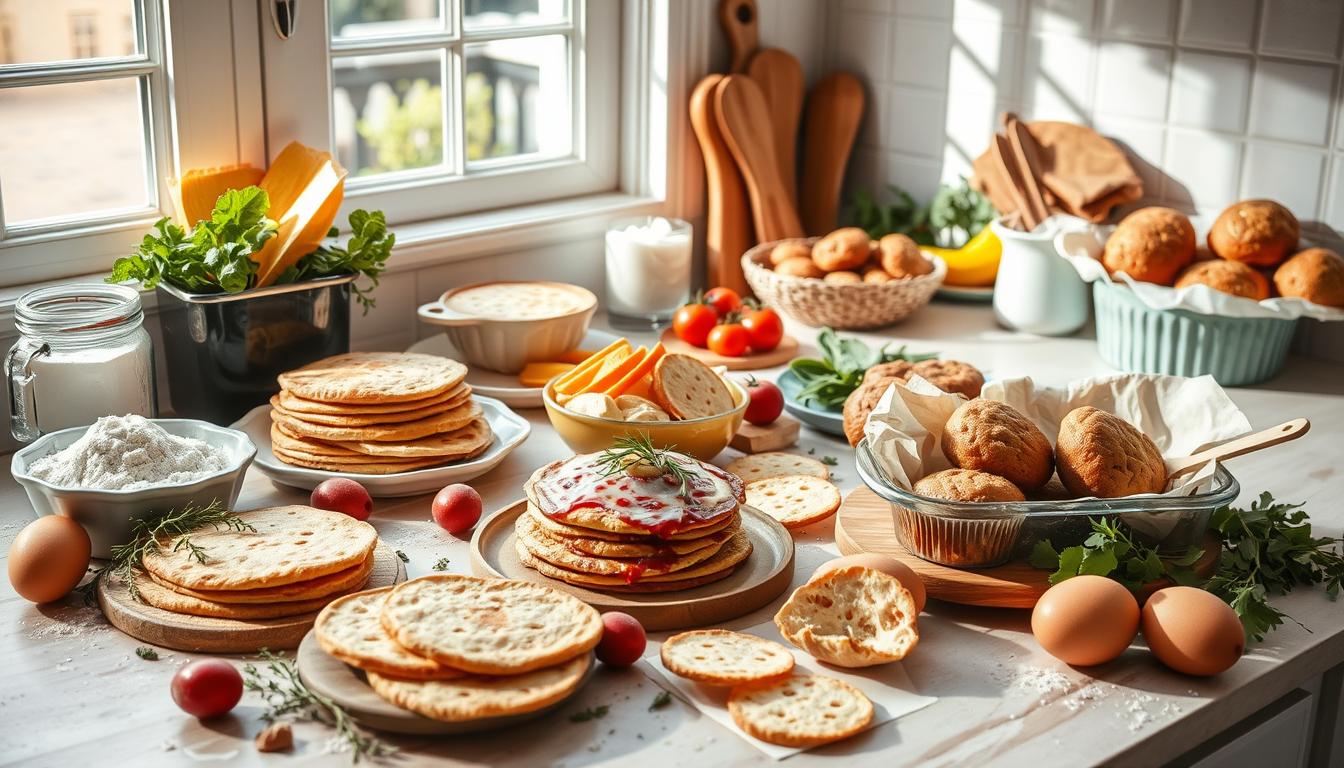Every time I feed my sourdough starter, I used to feel guilty about the leftover. That sticky, tangy mixture seemed too good to waste. But what if I told you it could become the secret ingredient in many tasty dishes?
Sourdough discard recipes are more than just a trick. They’re a way to bake sustainably, turning waste into tasty meals. Most bakers toss out some starter during feeding. Now, you can turn that discard into something amazing.
Whether you’re an experienced baker or just starting out, these recipes will change how you see leftover starter. You can make everything from fluffy pancakes to crispy crackers. The possibilities are endless.
Key Takeaways
- Sourdough discard can be used in multiple recipes
- Reduce food waste by repurposing starter
- Discover versatile cooking techniques
- Enhance flavor profiles with leftover sourdough starter
- Learn sustainable baking practices
Understanding Sourdough Discard: What It Is and Why It Matters

Sourdough starter discard is key to a healthy sourdough culture. When you feed your starter, you get leftover mix that’s not for bread. This extra starter is not waste; it’s a chance to get creative and cut down on waste.
The science behind sourdough discard is interesting. Bakers take out some starter to add fresh flour and water. This keeps the starter’s yeast and bacteria in balance, ensuring good fermentation.
The Composition of Sourdough Discard
Your sourdough discard usually has:
- Partially fermented flour
- Water
- Active and dormant microorganisms
- Mild acidic characteristics
Benefits of Saving Your Discard
Using your discard has many benefits:
- It cuts down on kitchen waste
- It makes tasty alternative recipes
- It saves money on ingredients
- It adds flavor to baked goods
Active vs Inactive Discard Differences
Knowing if your discard is active or inactive is important. Active discard comes from a recently fed starter at room temperature. Inactive discard is in the fridge. The texture and fermentation ability are different between these two.
“Waste not, want not” – this saying perfectly describes the art of sourdough starter management!
Pro tip: You can store your sourdough discard in the fridge for up to two weeks. It’s a versatile ingredient for many recipes.
Essential Storage Tips for Leftover Starter
Keeping your sourdough starter alive is key to sustainable baking. The right storage keeps your discard fresh and ready for baking. Let’s look at the best ways to keep your starter in top shape.

There are several ways to store your sourdough starter. These methods help keep it fresh for longer:
- Refrigerator Storage: Your main way to keep it fresh
- Freezer Preservation: Great for those who bake less often
- Room Temperature: Best for bakers who use it often
Refrigerator Storage Techniques
Put your sourdough discard in a 1-quart mason jar with a loose lid. The fridge keeps it good for 3-4 weeks without needing to feed it. Try to use it within a week to keep the taste great and avoid over-fermentation.
“The key to successful sourdough starter storage is understanding its living ecosystem.” – Professional Baker’s Wisdom
| Storage Location | Duration | Feeding Frequency |
|---|---|---|
| Refrigerator | Up to 4 weeks | Once a month |
| Room Temperature | 3-5 days | Once a week |
| Freezer | Several months | Not applicable |
For sustainable baking, use containers like glazed ceramic or glass. Look out for mold or color changes. These signs mean it’s time to get rid of your starter.
Freezing Your Discard
Freezing is a great way to keep your starter for months. Just thaw it when you’re ready to bake. This method cuts down on waste and keeps your starter ready for future baking.
Sweet Breakfast Transformations
Explore creative sourdough recipes that change your morning. Sourdough bread baking is more than just making loaves. It opens the door to amazing breakfast ideas that will make your kitchen buzz.

Leftover sourdough starter is a game-changer for breakfast. It turns simple discard into amazing morning dishes that wow your family.
Fluffy Sourdough Pancakes
Overnight fermentation makes pancakes incredibly fluffy. The trick is to mix your batter the night before. This lets flavors meld and the texture become light and airy.
- Combine wet and dry ingredients except leavening agents
- Chill batter overnight for enhanced flavor
- Add baking powder just before cooking
- Yield: Up to 12 pancakes per batch
Crispy Belgian-Style Waffles
Sourdough discard makes waffles crispy and flavorful. Your waffle iron will become your go-to breakfast tool.
| Ingredient | Quantity | Purpose |
|---|---|---|
| Sourdough Discard | 1 cup | Base for tangy flavor |
| Eggs | 2 large | Binding and richness |
| Butter | 1/4 cup | Crispness and flavor |
Cinnamon Roll Variations
Turn sourdough discard into delicious cinnamon rolls quickly. These rolls offer a healthier take on the classic breakfast treat.
“Sourdough cinnamon rolls prove that healthy can be delicious!” – Baking Enthuasiast
For success, prepare the dough the night before and let it rise slowly. Your breakfast will be filled with amazing flavor and texture.
Savory Sourdough Discard Recipes
Turn your leftover sourdough starter into tasty dishes. These recipes aren’t just for sweet treats. They can make your discard into savory delights that will surprise and please your taste buds.

Sourdough starter recipes are very versatile. Your discard can become a secret ingredient in the kitchen. It helps make amazing savory dishes that use up every bit of your starter.
Sourdough Discard Crackers: A Quick Favorite
Crackers are a simple way to use up your starter. Here’s a quick recipe to make them:
- 100g sourdough starter discard (about 1/2 cup)
- 60g flour of choice
- 20-30g unsalted butter or olive oil
- 1/4 teaspoon sea salt
- Optional seasonings or cheese
“Sourdough discard crackers are a game-changer for reducing food waste and creating delicious snacks!” – Professional Baker
To make them, mix the ingredients. Let the dough ferment for 2-6 hours. Then, roll it thin and bake at 350°F for 18-24 minutes. Your kitchen will smell amazing!
| Recipe Type | Discard Amount | Preparation Time |
|---|---|---|
| Sourdough Crackers | 1/2 cup | 30 minutes |
| Sourdough Pizza Crust | 1 1/2 cups | 2-3 hours |
There’s more to sourdough starter recipes than crackers. Try making savory quick breads, pizza crusts, and flatbreads. They show off the tangy flavor of fermented starter.
Pro tip: Try different flours and seasonings to make your sourdough recipes unique!
Baked Goods and Pastries
Turning sourdough discard into tasty baked goods is a fun journey. It turns kitchen waste into treats that amaze your taste buds.
Using sourdough discard recipes is a great way to cut down on waste. It also makes pastries more flavorful because of the fermentation process.
Tender Scones and Biscuits
Sourdough biscuits are known for their flaky texture. You can add different things to them, like:
- Dried fruits
- Nuts
- Chocolate chips
- Herbs and cheese
Chocolate Cake Magic
A chocolate loaf cake gets even better with sourdough discard. The tanginess balances the sweetness, making it a special dessert.
| Baked Good | Preparation Time | Unique Characteristic |
|---|---|---|
| Sourdough Chocolate Cake | 45 minutes | Reduced sweetness, complex flavor profile |
| Sourdough Biscuits | 30 minutes | Ultra-light and flaky texture |
Banana Bread Innovations
Banana bread gets a gourmet twist with sourdough discard. Those overripe bananas make it moist and tangy, taking the classic recipe to new heights.
Pro tip: Use very ripe bananas for maximum flavor and natural sweetness in your sourdough banana bread!
By baking with sourdough discard, you’re making delicious treats and helping the planet. It’s a creative way to reduce waste and enhance flavors.
Quick Snacks and Crackers
Turn your sourdough starter discard into tasty snacks. This way, you reduce food waste and enjoy great flavors. Homemade crackers are a perfect choice for bakers who want to make the most of their starter.
Creating snacks from sourdough starter is rewarding. These crackers are not only delicious but also a clever way to use up your starter.
Essential Cracker Recipe Ingredients
- 1 cup (200 grams) sourdough discard
- 1/2 cup (56 grams) rye flour
- 1/2 cup (56 grams) all-purpose flour
- 4 tablespoons (57 grams) unsalted butter
- Salt to taste
Baking Instructions
- Preheat oven to 350°F
- Mix all ingredients thoroughly
- Roll dough to 1/16 inch thickness
- Cut into desired cracker shapes
- Bake for 20-25 minutes
Pro tip: Chill the dough for up to 24 hours to enhance flavor and make rolling easier.
“Sourdough discard doesn’t have to be waste—it can be your secret weapon for creating delicious, homemade snacks!” – Artisan Baker’s Handbook
Nutritional Highlights per 5 Crackers
Each serving of these sourdough starter crackers provides:
- Calories: 15 kcal
- Carbohydrates: 2g
- Protein: 0.2g
- Fat: 1g
By making crackers from your sourdough discard, you’re not just enjoying a snack. You’re also practicing sustainable baking and cutting down on kitchen waste.
Tips for Recipe Success and Texture Control
Mastering sourdough bread baking is all about the art of using sourdough starter discard. Success comes from understanding a few key factors. These can greatly improve your baking.
Hydration Adjustments for Perfect Texture
Getting the right texture in sourdough recipes starts with accurate hydration. Here are some important tips:
- Measure your sourdough discard carefully
- Adjust flour and water quantities as needed
- Use a 1:5:5 feeding ratio for the best starter health
“The secret to great sourdough is understanding its living nature.” – Professional Baker
Temperature Considerations
Temperature is key in sourdough bread baking. Your starter’s health depends on the temperature around it.
| Temperature Range | Starter Performance |
|---|---|
| 68-72°F | Optimal fermentation |
| Below 65°F | Slower fermentation |
| Above 80°F | Rapid fermentation |
Timing Your Bakes
Timing is everything in sourdough baking. Most starters are at their peak 4-8 hours after feeding. Knowing this helps you get perfectly risen bread.
Pro tip: When using sourdough discard, subtract half its weight from your recipe’s flour and water. This keeps hydration balanced and results consistent.
Sustainable Baking Practices with Discard
Reducing food waste is a big challenge in sustainable baking. Sourdough fans can help a lot by finding new uses for their sourdough discard. Did you know that 21% of the US waste stream is food that’s thrown away?
“Every spoonful of sourdough discard is an opportunity to create something delicious while supporting environmental sustainability.”
Here are some ways to bake sustainably with your sourdough discard:
- Keep a smaller starter to minimize waste
- Store discard in the freezer for up to six months
- Share excess starter with friends or local baking communities
- Experiment with discard in various recipes
Knowing how to manage your starter is important to cut down on waste. A good rule for a smaller starter is to use 40 grams of flour and water for a small amount of starter. This keeps your sourdough culture lean and efficient.
| Sustainable Baking Practice | Impact |
|---|---|
| Minimizing Starter Size | Reduces weekly discard volume |
| Freezing Discard | Extends usability up to 6 months |
| Creative Recipe Utilization | Transforms waste into tasty foods |
By adopting these sustainable baking practices, you not only cut down on food waste. You also help make bread making more eco-friendly. Every small action helps make your kitchen more sustainable.
Conclusion
Exploring sourdough discard recipes opens a world of creativity in cooking. You’ve seen how leftover starter can be turned into tasty treats. From chocolate chip cookies to various baked goods, it’s clear that leftover starter is not waste.
These recipes show that sourdough discard can do more than just bake. You’ve seen how it can add unique flavors and textures to your dishes. This makes it easy to reduce food waste in your kitchen.
As you keep exploring sourdough, remember that every discard is a chance to be creative. You can make quick snacks or fancy pastries. The skills you’ve learned will help you bake more sustainably and deliciously.
Start your sourdough journey with curiosity and passion. The recipes you’ve found are just the start of a tasty journey. They connect you to old baking traditions and help reduce food waste. Your sourdough discard is now a valuable ingredient, ready to be used.



